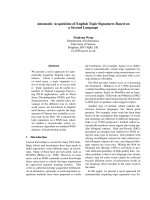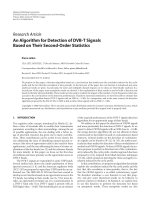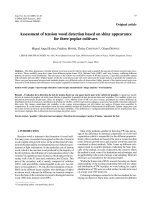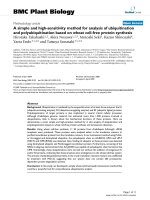design of a solar model for controlling brightness levels of a led system based on a light sensor
Bạn đang xem bản rút gọn của tài liệu. Xem và tải ngay bản đầy đủ của tài liệu tại đây (6.6 MB, 47 trang )
<span class="text_page_counter">Trang 1</span><div class="page_container" data-page="1">
<b>HO CHI MINH CITY UNIVERSITY OF TECHNOLOGY AND EDUCATIONFACULTY FOR HIGH QUALITY TRAINING</b>
<b>GRADUATION THESIS</b>
<b>MAJOR: ELECTRONICS AND COMMUNICATIONENGINEERING TECHNOLOGY</b>
<b>DESIGN OF A SOLAR MODEL FOR CONTROLLING BRIGHTNESS LEVELS OF A LED SYSTEM BASED ON A LIGHT SENSOR</b>
<b>ADVISOR: PhD. NGUYEN THANH NHIA</b>
</div><span class="text_page_counter">Trang 2</span><div class="page_container" data-page="2"><b>HO CHI MINH CITY UNIVERSITY OF TECHNOLOGY AND EDUCATIONFACULTY FOR HIGH QUALITY TRAINING</b>
<b>GRADUATION THESIS</b>
<b>MAJOR: ELECTRONICS AND COMMUNICATIONENGINEERING TECHNOLOGY</b>
<b>DESIGN OF A SOLAR MODEL FOR CONTROLLING BRIGHTNESS LEVELS OF A LED SYSTEM BASED ON A LIGHT SENSOR</b>
<b>ADVISOR: PhD. NGUYEN THANH NHIA</b>
</div><span class="text_page_counter">Trang 3</span><div class="page_container" data-page="3">Foremost, we would like to express our sincere thanks to the lectures in the Faculty of Hight Quality Training. During the time of studying at school, teachers were dedicated to teaching and imparting out team knowledge, experience, and motivation in the learning process.
Moreover, we would like to express my gratitude for his continued support and encouragement: Nguyen Thanh Nghia. We consider that: His guidance and advice are the best opportunity for us to complete this thesis.
Another, we would like to thank our friends who share knowledge and valuable experiences during the implementation of the thesis
Finally, we would like to thank our families who have put in the time, effort, and support our team during the implementation of this thesis.
Sincerely thank you!
Ho Chi Minh City, Dec 28, 2021
</div><span class="text_page_counter">Trang 4</span><div class="page_container" data-page="4"><b>A GUARANTEE</b>
We here with formally declare that this thesis is our research and implementation. I have not copied from any published articles without quoting the source. If there is any violation, I accept full responsibility.
<b> Author</b>
(Sign with full name)
</div><span class="text_page_counter">Trang 5</span><div class="page_container" data-page="5">Today, when technology is increasingly developed, people’s lives and needs are improved, research are more and more interested in technical and technological applications that bring benefits and do not cause harm to the enviroment. When it comes to green energy, it is impossible not to mention that the abudanet energy that is avaible and does not cause harm to the earth’s enviroment is the source of solar energy. Currently, builduings and commercial areas all the use solar energy as the main fuel source to convert electricity to light complexes, commercial areas, or buildings. That’s why our team chose the topic : ”Design of a solar model for controlling brightness levels of a LED system based on a light sensor” to modoernize street light equipment by using solar energy and adjusting it. The brightness is suitable for shining in when it is dark compared to the traditional street lights today. The system uses the central microcontroller ESP8266, light sensor BH1750, solar panel, storage battery, and LED chip 2835, etc. Because of improving the utility of streets light using solar energy, the thesis has designed a webserver using ESP8266 to convert WIFI so that can display information about the percentage of the battery reserve, the brightness level of the lights, and the operating mode that users can use it more conveniently and can monitor when place have WIFI.
The result after the poject is that the LED works stably and automatically like the LEDs solde on the market as the goal of the topic. The system has the advantage of being able to support users to monitor thorugh the webserver, have longer lighting capacity thanks to the use of PWM technology. However, the system also has the disadvantage that our team is working on a model, so some aesthetic problems are not high, but sill ensure wate resistance when the device is operating outdoors.
</div><span class="text_page_counter">Trang 6</span><div class="page_container" data-page="6"><b>CHAPTER 2. LITERATURE REVIEW...4</b>
2.1. S<small>OLAR ENERGY EXPLOITATION AND PRODUCTS</small>...4
2.1.2. Application of solar panel...4
2.2. E<small>NERGY-OPTIMIZING SYSTEMS...5</small>
2.2.1 LEDs replace other lamps in application...5
2.2.2 Pulse width modulation (PWM)...6
</div><span class="text_page_counter">Trang 7</span><div class="page_container" data-page="7">3.1. INTRODUCTION...10
3.2. HARDWARE CALCULATION AND DESIGN...10
3.2.1. Block diagram...10
3.2.2. Calculate and design circuit diagrams...11
a. Central processing block (ESP8266)...11
b. Design of PWM circuit...12
c. Design of switch circuit...14
d. Design of divider circuit...17
e. Design of source circuit...18
f. Principle of operation...22
g. Principle of diagram...23
3.3. SOFTWARE DESIGN...23
3.3.1. Flowchart of main program...23
3.3.2. Flowchart of battery saver...25
3.3.3. Flowchart of operating mode...25
3.3.4. Flowchart of voltage check...26
3.3.5. Flowchart of update webserver data...27
<b>CHAPTER 4. CONSTRUCTION OF THE SYSTEM...29</b>
<b>CHAPTER 5. RESULT AND DISCUSSION...35</b>
5.1. RESULT OF MODEL EXECUTION ...35
</div><span class="text_page_counter">Trang 8</span><div class="page_container" data-page="8">5.1.2. The system’s console...36
a. Main screen interface...36
b. Auto mode interface...37
c. Manual mode interface...38
5.2. COMMENTS AND REVIEWS...40
5.3. INSTRUCTION DOCUMENT...40
5.4. ESTIMATING CONSTRUCTION COSTS...41
<b>CHAPTER 6. CONCLUSION AND FUTURE WORK...43</b>
6.1. CONCLUSION...43
6.2. FUTURE WORK...43
<b>REFERENCE ... 44</b>
<b>APPENDIX...46</b>
</div><span class="text_page_counter">Trang 9</span><div class="page_container" data-page="9"><b>ABBREVIATIONS</b>
</div><span class="text_page_counter">Trang 10</span><div class="page_container" data-page="10">SDIO Secure Digital Input Output
UART Universal asynchronous Receiver Transmitter
</div><span class="text_page_counter">Trang 11</span><div class="page_container" data-page="11"><b>LIST OF TA</b>
Table 2. 1 Comparision of PWH Techniques...6
YTable 4. 1 List of components used in the system...29
Table 4. 2 List of components used for simulati...32
YTable 5. 1 Experimental data of LED in auto mode...40
Table 5. 2 Experimental data of LED in manual mode...40
Table 5. 3 Cost for components, materials used in the model...4 Y
</div><span class="text_page_counter">Trang 12</span><div class="page_container" data-page="12"><b>LIST OF F</b>
Figure 2. 1 The front of system model after completion...4
Figure 2. 2 Module of the system...5
Figure 2. 3 A LED chip 2835...7
Figure 2. 4 Light intensity sensor BH1750...9
YFigure 3. 1 Block diagram of system...10
Figure 3. 2 Circuit of central processing...11
Figure 3. 3 PWM circuit...13
Figure 3. 4 Switch circuit...14
Figure 3. 5 Schematic of divider circuit...17
Figure 3. 6 Schematic of charging circuit...18
Figure 3. 7 Schematic of power supply circuit...20
Figure 3. 8 Schematic diagram of the whole system...23
Figure 3. 9 Flowchart of main program...24
Figure 3. 10 Flowchart of battery saver...25
Figure 3. 11 Flowchart of operating mode...26
Figure 3. 12 Flowchart of the voltage check...27
Figure 3. 13 Flowchart of update webserver data...28
YFigure 4. 1 Front of PCB circuit...30
Figure 4. 2 Backside of PCB control circuit...31
Figure 4. 3 Front of board circuit...31
Figure 4. 4 Backside of board circuit...32
Figure 4. 5 Model of the system...33
Figure 4. 6 Webserver interface on IPad...33
Figure 4. 7 Webserver interface on computer...34
YFigure 5. 1 Module of LED...35
Figure 5. 2 Inside of the LED module...36
</div><span class="text_page_counter">Trang 13</span><div class="page_container" data-page="13">Figure 5. 3 Webserver interface after logging browser...36
Figure 5. 4 Webserver interface with auto button ON...37
Figure 5. 5 Auto mode with LED on...37
Figure 5. 6 Auto mode with LED off...38
Figure 5. 7 Webserver interface with manual button ON...38
Figure 5. 8 Manual mode with LED off...39
Figure 5. 9 Manual mode with LED on...39
</div><span class="text_page_counter">Trang 14</span><div class="page_container" data-page="14"><b>CHAPTER 1: INTRODUCTION</b>
<b>1.1 OVERVIEW</b>The development of science and technology has significantly contributed to the change in our life. Science and technology are drastically developing, which increases energy consumption leading to the depletion of energy resources. Therefore, we need to find a solution to save energy while ensuring the efficiency of our equipment.
Nowadays, in addition to exploiting energy from heat and water to produce electricity, we are gradually familiar with phrases such as: “solar electricity”. The fact that we exploit and use solar energy is one the “green solutions'' to find new energy sources without causing negative impacts on the environment. However, so that we can waste these sources of energy. In the scientific paper: “Solar energy for electricity and fuels” by Olle Ingana s, Villy Sundstro m, research on energy conversion and solar energy applications [1]. Their research the benefits of using solar energy, and solar energy receiving materials. In particularly, they further researched artificial photosynthesis, methods to produce direct solar fuels. It can also be shown that the impact of finding new energy and saving it is an important issue. In addition, the topic “Thiết kế chế tạo bộ điều khiển đèn chiếu sáng công cộng sử dụng năng lượng mặt trời” of Vu Tien Dat, Nguyen Minh Vuong, on manufacturing an optimal charge controller for batteries in the energy lamp system are based on a chip using ATmega128 connected to the Sim900 module for users to control the lights through the phone [2]. The account also shows the importance of energy storage and environmental protection.
In conclusion, our team decided to carry out the thesis “Design of a solar model for controlling brightness levels of a LED system based on a light sensor” to create an automatic controller capable of optimizing the duration to use of solar lights.
<b>1.2 RESEARCH OBJECTIVE</b>
Design and construction of a controller for solar LED lights is using ESP8266 microcontroller as an electrical energy control processor to control the brightness of LED bulbs. At the same time, it allows users to monitor parameters and the remaining voltage level in the reserve battery.
<b>1.3 LIMITATION </b>
The thesis has some limitations as follows:
</div><span class="text_page_counter">Trang 15</span><div class="page_container" data-page="15">The thesis uses conventional energy lamps sold in the market, so the circuit has not been standardized for diverse uses.
The system applies to rural areas, where solar lights are often used for lighting. The system is not used in place where no internet connection.
<b>1.4 RESEARCH CONTENT</b>
This thesis of implementation includes the following contents:
<b>Content 1: Refer to document, read and summarize to find the development</b>
direction of the thesis.
<b>Content 2: Block diagram design and description them.</b>
<b>Content 3: Design, calculate and connect module such as ESP8266, BH1750.Content 4: Hardware design and construction, actual circuit construction.Content 5: Write a program for the controller.</b>
<b>Content 6: Write the program to display a website.Content 7: Assemble and complete the module.</b>
<b>Content 8: Running and testing the system for completing.Content 9: Write a report.</b>
<b>Content 10: Prepare slides for defense.1.5 THESIS SUMMARY</b>
<b>Chapter 1: Introduction</b>
This part introduces the reasons for choosing the topic, the objectives, and limitations of the research, the research contents and presents the layout of the research thesis.
<b>Chapter 2: Background</b>
This section presents the basic theory, the parameters of the components as a premise to implement the thesis, using the researched topics as the basis for reference.
<b>Chapter 3: Calculation and design</b>
This chapter presents the calculation of the system construction and website design to display information based on the theory.
</div><span class="text_page_counter">Trang 16</span><div class="page_container" data-page="16">This chapter presents the results, images of models, and data collected during the implementation of the thesis, comments on the thesis and future development direction of the thesis.
<b>Chapter 6: Conclusion and future work</b>
In this section, we present the conclusions and directions of this thesis.
</div><span class="text_page_counter">Trang 17</span><div class="page_container" data-page="17"><b>CHAPTER 2. LITERATURE REVIEW</b>
<b>2.1. SOLAR ENERGY EXPLOITATION AND PRODUCTS </b>When the solar panel system is widely used, the model of automatic rotation of solar panels is more applied. The model can increase the efficiency of photovoltaic income for maximum and best power conversion.
Figure 2. 1 The front of system model after completion.
The model can help the solar panels to charge maximum energy, but it has disadvantages because of angular deviation due to Servo noise and low energy input to the model size [3].
<b>2.1.2. Application of solar panel</b>
In [4], the solar panel is used as a component to absorb light directly from the sun and convert it into electricity to help the public lighting system At the same time, the<b>. </b>
device has the advantage of stable and durable operation.
</div><span class="text_page_counter">Trang 18</span><div class="page_container" data-page="18">Figure 2. 2 Module of the system.
<b>2.2. ENERGY-OPTIMIZING SYSTEMS 2.2.1 LEDs replace other lamps in application. </b>
There are a wide range of lights which are increasingly being used for different lightning purposes both indoors and outdoors. In lighting systems, Light Emitting Diode (LED) is a new technology and is being developed continuously.
<b>2.2.2 Pulse width modulation (PWM)</b>
In the research [6], using PWM control at each cycle will reduce the load current-included distortion in the phase control circuit. Also, at high switching frequencies, the maximum harmonics can be reduced by using a simple capacitance. Total harmonic distortion can be minimized by using PWM. Thus, authors have concluded that the PWM technique helps to improve power quality. Moreover, out of all the PWM technique, SWPM is the best modifier.
Table 2. 1 Comparision of PWH Techniques.
</div><span class="text_page_counter">Trang 19</span><div class="page_container" data-page="19"><b>2.3. HARDWARE INTRODUCTION 2.3.1. A LED Chip 2835</b>
Chip LEDs have a compact design of 2.8 x 3.5 x 0.7mm, have a typical forward voltage of 5V, maximum current of 240mA. LEDs operate at 0.5W power, and test current at 150mA, have a temperature test of 25 degrees Celsius [8].
Figure 2. 3 A LED chip 2835
<b>2.3.2. Solar Panel</b>
Currently, the using of solar batteries for green energy conversion is in high demand. In topics [2], the author used solar batteries. However, depending on the purpose of using, the panels have different sizes and parameters. Therefore, solar panels are expensive compared to conventional rechargeable batteries, the using of solar panel can work in area where it is difficult to build electric power line or complex terrain.
<b>2.3.3. Microcontroller ESP8266</b>
In the thesis request, the team will use the ESP8266 module to be able to exchange information with the light sensor and send data to the database via WIFI. The ESP8266 module is developed based on the ESP8266EX chip to meet the technical requirements in the Internet of things industry.
<b>2.3.4. Light intensity sensor BH1750</b>
In the thesis [2], sensor BH1750 was used to collect data and information in light sensing. Therefore, in this topic, my group chose to use the BH1750 sensor to collect data and information about sunlight intensity to calculate the ability to optimize the operating time of solar lights.
</div><span class="text_page_counter">Trang 23</span><div class="page_container" data-page="23">Calculation of the resistance when applying Ohm’s law is as follows:
Choose as 220Ω as appropriate.
For the LED panel output to work stably, we design the FET at the GND terminal to avoid the voltage drop on the FET from affecting the LED board. Since the number of LEDs that used is 180 LEDs of 2835 SMD has an average current consumption of 60mA at 3V (according to the datasheet), so the total current through the FET is calculated:
<b>c. Design of switch circuit</b>
The circuit is designed based on the digital signal by GPIO12 pin outputs (HIGH level is 3.3V, LOW level is 0V). The switch block has two measurement mode: measuring the voltage of the reserve battery and measuring the voltage of the PWM output.
</div><span class="text_page_counter">Trang 24</span><div class="page_container" data-page="24">Figure 3. 4 Switch circuit
<b>d. Design of divider circuit</b>
To measure the voltage of 3.3V with the ESP8266 microcontroller, we need to scale the value to 1V because the allowable scale of the ESP8266 is only from 0V to 1V. So, the voltage divider bridge circuit need to be set up to use for measurement.
Figure 3. 5 Schematic of divider circuit
<b>e. Design of source circuit </b>
The main source of power is from batteries and solar panel. In the thesis, a battery is used to supply power to LED and microcontroller that will be charge by solar panel.
<b>f. Principle of operation</b>
The system designed in thesis works entirely with energy from the sun. The power source for the systems is designed to include: a solar panel and a battery pack. Specifically, the charging source includes charging with a solar panel 6V and power
</div>








